National Monuments Authority recently organised a seminar where scholars drawn from various top educational institutions of the country discussed ‘the real history’ of Delhi and contribution of Maharaja Anangpal-II who founded the city
-Sushant Bharti
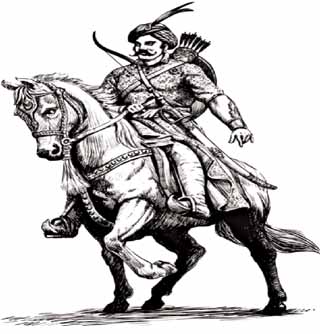
Sketch of Maharaja Anangpal-II
Delhi has been the centre of ruling power since ancient times for many rulers and dynasties. The city finds its reference in many ancient and medieval texts which talk about the glory and strength of rulers who had their seats of power here once upon a time. Ancient texts specify a location on the bank of the Yamuna, where Indra had performed worship to please Bhagwan Vishnu. This was done in the city of Delhi. The city’s sacred significance was enhanced during the Mahabharat era by the Pandavas, who made this city their new capital.
Indraprastha remained a pre-eminent centre on the Uttarapath since the Mauryan period, after which the settlement shifted from the bank of river Yamuna to the southern part near the Aravalli’s where the city named Yoginipura came into existence in 10th century CE by the Tomar dynasty. Maharaja Anangpal Tomar-II (between 1052 to 1060 CE) laid down the foundation of the city of Dhillika or Dhilli, which finds its mention in the Bijolia, Sarban and other Sanskrit inscriptions.
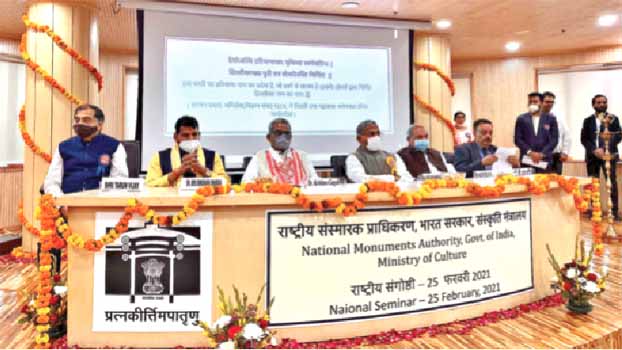
NMA chairperson Tarun Vijay, Lok Sabha MP Brij Bhushan Sharan, RSS Sah Sarkaryavah Dr Krishna Gopal, Deputy Chairman of Rajya Sabha Harivansh Narayan, Minister of Agriculture Narendra Singh Tomar and noted archaeologist Dr BR Mani during a session on the role of 11th century King Anangpal Tomar-II, who set up Delhi with its then name Dhilli or Dhillika after an inscription on the
pillar was found in Delhi
pillar was found in Delhi
National Monuments Authority (NMA), under the chairmanship of Tarun Vijay, Director, NMA, organised a one-day national seminar on the theme “Founder of Delhi: King Anangpal Tomar-II” at Archaeological Survey of India (ASI) headquarters in New Delhi recently. The seminar was convened by BR Mani, former Addl. Director-General ASI and DG, National Museum. It was attended by many leading scholars, historians and archaeologists who have contributed to this unattended facet of Delhi’s history. BR Mani, then Superintendent Archaeologist in Delhi Circle of ASI, excavated Lal Kot’s area between 1991 and 1992, which revealed many major archaeological evidences for the scholars to attribute the influential share of Tomars on the ancient history of Delhi. Before BR Mani’s discovery, the site was excavated by YD Sharma from 1957 to 1961. It was mainly confined to the fortifications wall.
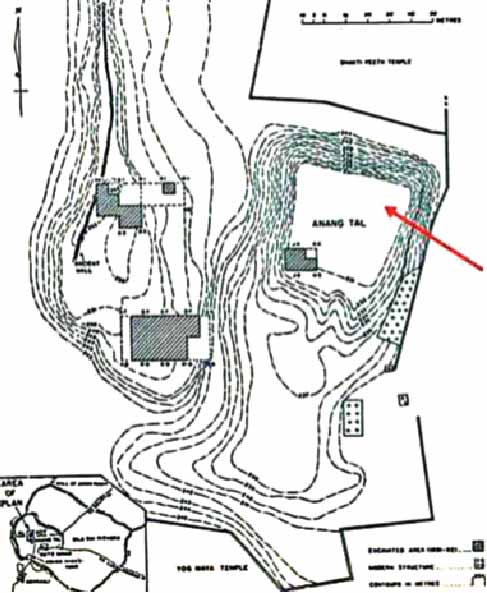
Plan of Lal Kot (Source Excavation Report of Lal Kot 1991-1992)
Maharaja Anangpal-II belonged to the Tomar dynasty, which earlier ruled Kannauj after the downfall of Gurjar Partiharas from 10th century CE onwards. The dynastic records attributed to Tomars were traced by the founder Director General of ASI Sir Alexander Cunningham from the list mentioned by Abul Fazal in ‘Ain-i-Akbari’ and from other manuscripts he retrieved from Bikaner, Gwalior, Kumaon and Garhwal. These manuscripts gave the list of Tomar rulers starting from 8th CE. The list comprises 19 rulers wherein Maharaja Anangpal Tomar-II is accorded to be the 16th ruler of the dynasty.
Inscription on Famous Iron Pillar
The city of Indraprastha, located on the banks of river Yamuna, lost its glory much before the time of Maharaja Anangpal Tomar-II, who was instrumental in the construction of Lal Kotor, the fortified city of Dhilli/Dhillika. The earliest possible inscription supporting this fact comes from the one inscribed on the famous Iron Pillar or Vishnu Dhwaja at Qutub complex, which was deciphered by famous archaeologist Rai Bahadur Daya Ram Sahani which says that, “Samvat Dhilli 1109 AmgapalaVadi”
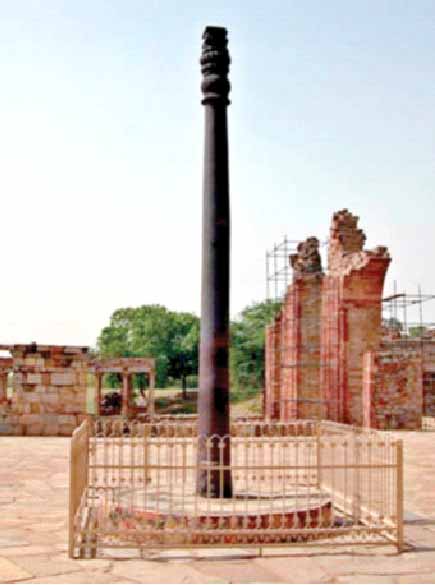
Iron Pillar or Vishnu Dhwaja at Qutub Complex (Source Wikipedia). The inscription and its date are extremely relevant because it coincides with the other archaeological evidence which supports the establishment of the new city in Lal Kot premises. Also, the famous narrative of “establishment of an iron nail,” i.e. “KilliDhilli” where Iron Pillar, a symbolic nail, was used by Maharaja Anangpal Tomar-II, to lay foundation of the new city, finds mention in this inscription
“In Samvat 1109 (1052 CE), Anangpal peopled Dilli”.
But in the national seminar, BR Mani gave a different interpretation to this inscription. According to him, the inscription reads as follows,“Samvat Kinlii 1109
Angapala Badi”.
“In Samvat 1109 (1052 CE), Anangpal tightened the nail (Iron Pillar). The inscription and its date are extremely relevant because it coincides with the other archaeological evidence which supports the establishment of the new city in Lal Kot premises. Also, the famous narrative of “establishment of an iron nail,” i.e. “KilliDhilli” where Iron Pillar, a symbolic nail, was used by Maharaja Anangpal Tomar-II, to lay foundation of the new city, finds mention in this inscription. Ths Story of KIlliDhilli has been mentioned by slightly different versions by various scholars and was recorded by Sir Alexander Cunningham himself.
The epigraphical evidence of Palam Baoli, which dates back to the time of Balban, i.e. 1274 CE, clearly indicates that Tomars first ruled the land of Hariyanaka. Subsequently, it was ruled by Chauhans and lastly by Saka rulers. According to the inscription, all the rulers of the Slave dynasty up to Balban are considered as Saka rulers. The name of the city in the inscription is mentioned as Dhillipura with an alternative name Yoginipura.
The archaeological evidence from the site, which dates back to the Gupta-Pratihara period, strongly suggests that this area comprises a temple complex called Yoginipura and later became Dhilli or Dhillika under Tomars. Also, as per the inscription in Quwatt Ul Islam and other oral traditions, Anangpal-II constructed 27 temples and a palace over this site. One can still see the famous Yogamaya temple located just beside the Qutub complex, which hints towards the ancient layer of Delhi before the Islamic occupation.
The last of the relevant inscription dates from 1328 CE from Mohammad Bin Tughlaq and is famous by the name Sarban stone inscription, having been found in the village of Sarban Sarai, the area now covered by present-day Rajpath. The inscription refers to the region being Hariyana, described as being like “Heaven on earth”. It talks of Sarban as being located in the pratigana (pargana) of Indraprastha. Also, it also affirms that the Tomars built the city of Dhilli.
The fortified city of Lal Kot is the earliest known fortification in Delhi, which Maharaja Anangpal-II constructed in the middle of the 11th century. The palace of Maharaja Anangpal Tomar-II has also been mentioned by Amir Khusrau in his works too. ‘Ain-i-Akbari’ and other few texts also indicate the residence of Qutubuddin Aibak and Iltutmish to be the original site of Lal Kot. Kushak Firozi, Kushak Sabj and Chabutra Nasira were the palace sites built by Mamluk sultans of Delhi in Lal Kot. Apart from that Anangapur Dam, Anangtal, Anangapur fort is believed to have been constructed by Maharaja Anangpal-II.
According to Dr Om Ji Upadhayay, Director (Research), ICHR who was a key speaker in the seminar, the historical evidence suggests that Delhi, under the Tomar dynasty rule, was a fairly minor town. Tomars, including Maharaja Anangpal II, had a very distinctive connection with Jain religious teachers, and some of their courtiers were from the Jain community as well. Nattal Sahu, one of the most influential people in the court of Maharaja Anangpal Tomar II, had commissioned a lavish Jain temple. During the same time, famous Jain scholar Shridhar wrote ‘Parshvanath Charitra’ in which he mentioned both Maharaja Anangpal II and Nattal Sahu, under whose patronage he carried his literary works dedicated to Jainism.
The archaeological evidence also showcases engineering capabilities of Anangpal Tomar. The Anagatal, Anangapur Dam and Surajkunda reservoir located in Faridabad are an excellent example of water harvesting techniques in that era. It shows the advanced capabilities and farsightedness of Maharaja Anangpal II. The location of Lal Kot beside the Aravalli would have triggered Maharaja Anangpal II to construct various hydraulic structures in order to create a catchment area for water harvesting.

Coins Attributed to Maharaja
While delivering his lecture in the seminar, GS Khwaja, former Director of Epigraphy Branch, ASI said, coins have a written text that reads as “Shri Killideva Pala Shri Samantadeva”. Shri Samantadeva has been like a tag line used for the Tomars, and Shri Killideva denotes the establishment of Iron Pillar by Maharaja Anangpal II in Lal Kot’s premises. He also added that many kings had used the impression of Nandi during the same time period when Tomars ruled the area of Lal Kot.
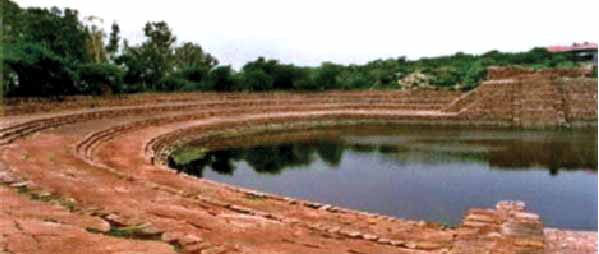
Surajkund water reservoir constructed by Anangapal-II (Source Wikipedia)
Maharaja Anangpal II died in 1081 CE, and according to various historical records, it’s asserted that he ruled Delhi prosperously for 29 years, 6 months and 18 days. With his demise, the command of Delhi went into the hands of Chauhan rulers of Ajmer. Within few years the Second Battle of Tarain, saw the heavy defeat of Prithviraj Chauhan by the hands of Mohammad Ghori. This ended the Hindu supremacy in Northern India which led to the advent of Islamic rule.
The seminar paved a bright opportunity for future scholars, historians, archaeologists, epigraphists, and other professionals to study this unattended era of Delhi’s history. The research institutions should now come forward and work together with scholars to reconstruct the historical timeline of Delhi and other parts of India that lacks primary resources.
(The writer is a Conservation Architect)



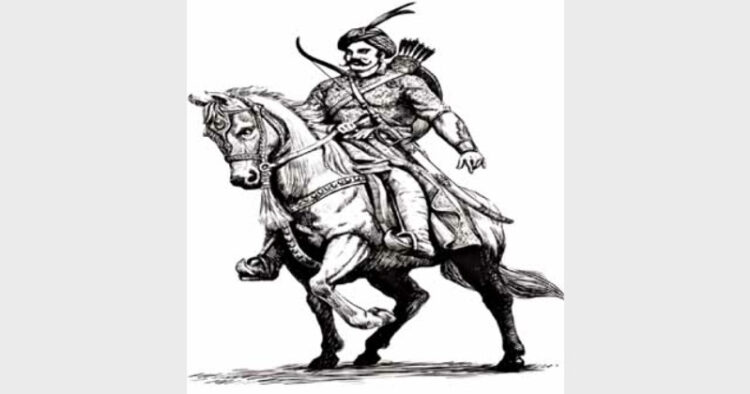










Comments